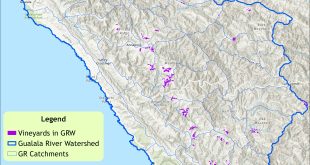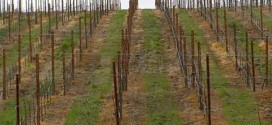Fermented Fallacies
Debunking the myths of Preservation Ranch
forestland vineyard development
Preservation Ranch‘s proponent, Premier Pacific Vineyards (PPV), originally devised its roughly 1,600 acre forest conversion proposal for vineyard development soon after the peak of the Pinot Noir wine fashion frenzy and “irrational exuberance” of the California residential real estate market around 2002.
At the time, the demand for wine country McMansions (“vineyard estates”) and Pinot Noir was presumed by some to be endless. Things have changed. But PPV’s justification for the project, and its excuses for permanent removal of coastal redwood forest to build more vineyards, have not, and they appear even more nakedly incredible than they did back in the Grape Rush days. We are providing an informal guided tour of PPV’s fallacies.
The core of PPV’s environmental sales pitch for Preservation Ranch is that vineyards are needed to be the economic engine for restoration of the forestlands in their 20,000 acre land ownership in the Gualala River watershed.
They argue that they are merely developing the ridgetops, and leaving everything on the forested slopes below (on slopes too steep to grow grapes under current law) alone or healing the so-called “wounded lands” with conservation-minded forestry practices, planting a million trees, placing conservation easements, and other so-called protections for its claim to “revitalized forests.” Hence the name “Preservation Ranch,” which was apparently not intended to be self-satirical.

Gualala River & redwood forest
1. Preservation Ranch is a MASSIVE DEVELOPMENT PROPOSAL, not a vineyard.
PPV is a developer, not a vineyard management company or winery. PPV is not proposing to grow grapes or sell grapes or make wine.
They are proposing to develop a sprawling all-weather road system across thousands of acres of old timberland to construct a network of vineyards, luxury home sites, worker housing, quarries, and reservoirs from the edge of the coastal fog belt to over 20 miles inland – as is clearly described in their permit application to Sonoma County. This development would occur entirely in 20,000 acres of land – 10% of the Gualala River watershed – that has been either in ranch or timber land use since the 19th century.
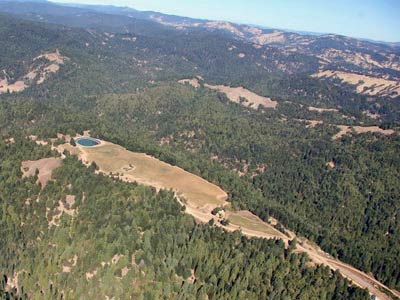
Evans Ridge vineyard development on ‘Preservation’ Ranch
Regardless of whether PPV is proposing vineyards or shopping malls, installing basic infrastructure for development across 20,000 acres – the all-weather road system, reservoirs, quarries, residences – is an irreversible catalyst for further development and intensification of resource extraction, and a huge pressure for future re-zoning to allow them. Roads make development destiny.
If PPV can ask for re-zoning from timber to mixed-use rural development to increase profit on investment, what would prevent subsequent landowners from increasing their profit on investment by lobbying for further zoning changes and more intensive land uses?
The existing road system and infrastructure is marginal – seasonal dirt timber roads and impassable old skid roads, many of which are derelict and actually forested over…. as close to “roadless” as privately owned forestlands get. They physically keep land uses restricted to timber and ranching. Once that physical restriction is ended by upgraded all-weather roads, intensification of land uses will never stop as long as economic forces exist to fuel them.
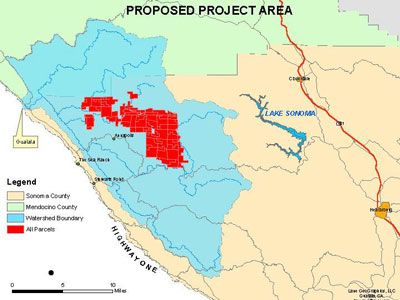
Preservation Ranch, in the heart of the Gualala River watershed
2. The forests of the “wounded lands” are healing themselves and don’t need the so-called economic engine vineyards to recover.
Excessive and aggressive past logging, and ongoing timber harvests, have degraded a lot of forestland in northwestern Sonoma County. But logging is a disturbance, and forests naturally recover from disturbances over decades – as long as they don’t lose all their soil, legacy structure of downed wood, and wildlife.
Forests don’t recover from permanent conversion to agriculture. But the can recover even from clear-cuts and landslides, as long as the surrounding matrix of unfragmented forestland remains. You can see this directly by using Google Earth to look at the extent of forest recovery, and the retention of significant areas of mature second-growth – even tiny pockets of old-growth trees and snags – in Preservation Ranch.
Even PPV’s own studies of forest habitat reveal that over 70% of the forest either met or exceeded the California Board of Forestry’s standards for “stocking” of conifers (commercial trees) back in 2006.
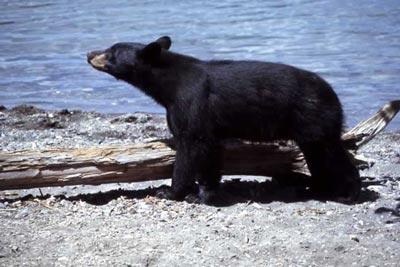
black bear (NPS)
And PPV’s cursory wildlife surveys revealed active mountain lion dens, fresh lion kills, black bear, golden eagles, northern spotted owls, burrowing owls, wood-rats, bats, potential sign of elk, and even a Swainson’s hawk beyond its known range. Lions and bears are among the most sensitive indicators of extensive, unfragmented forest with scattered openings for diverse habitat and abundant prey.
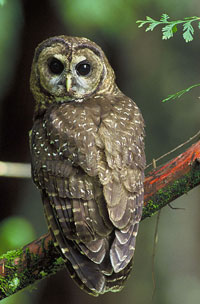 northern spotted owl (US FWS) |
Birds of mature forests, like pileated woodpeckers, also inhabit the “wounded” Preservation Ranch, as do wild orchids. The streams and riparian areas support steelhead and yellow-legged frogs. Yet the PPV doublespeak on its own findings is that the lands it proposes to convert to agriculture are “… relatively poor for growing trees, lack significant biological diversity and have lower value wildlife habitat compared to a well-managed forest…”
What is the point of proposing to plant “millions of conifers” in lands that meet or exceed state standards for tree density in over 70% of the area almost a decade ago? What is the point of taking an essentially roadless area that already supports wide-roaming large mammals, and building 85 miles of vineyard fence and 64 miles of permanent roads, to help “preserve” them?
Will grape growers in Preservation Ranch live in harmony with hungry resident bears on the other side of the vineyard fence at fall harvest time, or will they conduct business as usual – obtain depredation permits from the Department of Fish and Game to kill bears that break fences and eat grapes?
3. Gaming mitigation: forest leftovers as compensation for deforestation.
Preservation Ranch claims that it is merely converting 10% of its land acreage to grapes, and generously conserving 90%. In fact, it is consuming almost 100% of the land that is flat enough to legally plant grapes, and spreading development and road networks over all parts of its holdings that have land flat enough to support grapes.
The parts of the land that is too steep to plant grapes legally will be logged under their plan, with one uncut set-aside forest that is sandwiched between vineyard-fenced ridgetops, potential sources of pesticide drift, and permanent new roads.
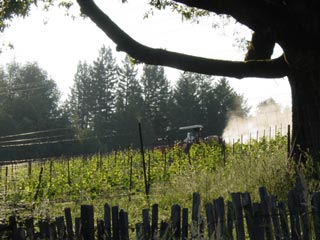
pesticide spraying near Annapolis
But the basic premise is that they want to have Sonoma County treat the non-agricultural leftovers that will be logged as mitigation for outright permanent loss of over 1,600 acres of forest. As esteemed environmental attorney Paul Carroll phrased it, “Leaving something behind is not a mitigation for environmental harm”, and it is hardly a way to offset 1,600 acres of irreversible net loss of forest soil, trees, wildlife, and plants.
4. Why deforest Sonoma County for grapes?
Why not use land already cleared for agriculture? This question was never taken seriously at the height of frenzied speculation in the expanding Pinot Noir market of the early 2000s, but it desperately needs to be taken seriously in the current vineyard real estate market and wine market.

Vineyard conversion near Annapolis
 I don’t see a need for more deforestation to have a great wine economy, because there is a lot of cleared I don’t see a need for more deforestation to have a great wine economy, because there is a lot of cleared  land already available. land already available.
– Adina Merelender, a UC Berkeley conservation biologist |
Vineyards, orchards, and other intensive agricultural lands are available for purchase or lease in Sonoma County. Why should the County, or state and federal agencies, allow irreversible deforestation to put in more vineyards when PPV has failed to prove that there aren’t less environmentally damaging alternatives that could serve the same basic purpose of growing quality grapes? How many new acres of grapes do we really need in Sonoma County?

Vineyard conversion near Annapolis
5. “Sustainable” agriculture in what century?
PPV touts its promises of “sustainable” agriculture in Preservation Ranch, but says nothing at all about what “sustainable” agriculture is, and whether it can obligate the subsequent vineyard owners to whom it sells land to farm “sustainably”…and given that Sonoma County can’t regulate agricultural practices, that’s a tall order.
And who would enforce requirements for “sustainable agriculture” on over 60 different vineyard owners? Is “sustainable” agriculture even possible for vineyards in the coast ranges? A recent study of climate change impacts on the California wine grape industry suggests not: increased frequency of extremely hot weather, increased duration and intensity of drought, are forecast to squeeze a lot of today’s premiere wine grape land out of existence.
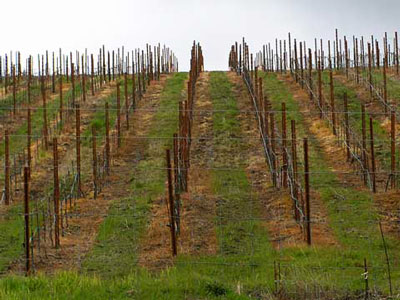
new vineyard sprayed with herbicide near Annapolis
  There are a lot more grape vineyards than there really is water for. There are a lot more grape vineyards than there really is water for.
– Brian Cluer, scientist at National Marine Fisheries Service |
6. The bottom line: there is no market for “Chainsaw wine.”
To most Californians, and most socially perceptive wine drinkers, it is fundamentally unacceptable to support conversion of redwoods to red wine.
 Chainsaw Wine |
The social stigma of rapacious deforestation for premium wine, when environmentally responsible alternative brands of equal or superior quality abound in the global marketplace, makes Preservation Ranch an economically infeasible enterprise.
This was not the case when it was first proposed almost 10 years ago, but the progressive ratcheting of adverse public opinion, following national news coverage of its repellant deforestation premise, has changed that [NYTimes, LATimes, AP].
Even if the economy rebounds and even if coastal Pinot Noir becomes perpetually fashionable, any wine label associated with redwood deforestation will inevitably be shunned by socially conscious and fashion-conscious wine buyers in California and beyond. The genie will not go back in the bottle: there is no returning to ignorance about what was sacrificed to produce wines on Preservation Ranch-developed vineyards.
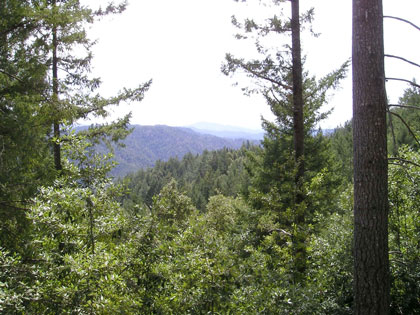
Gualala River Forest
 Friends of Gualala River Protecting the Gualala River watershed and the species living within it
Friends of Gualala River Protecting the Gualala River watershed and the species living within it
